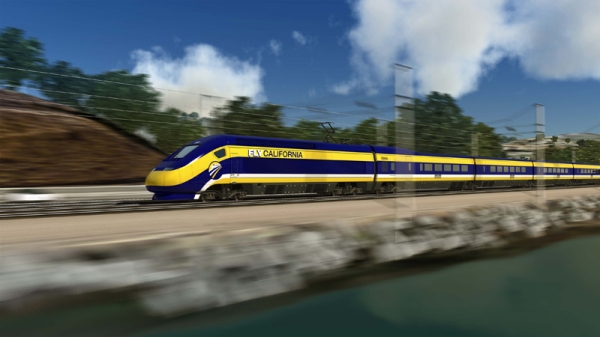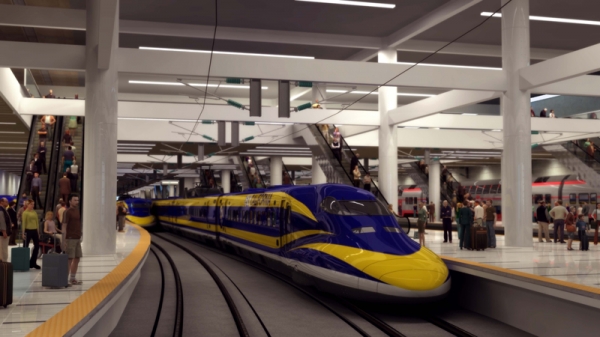The state agency charged with building California's high-speed rail system approved on Thursday a long-debated environmental analysis for the San Francisco-to-Los Angeles line -- a voluminous document that the project's opponents immediately characterized as an invitation to more lawsuits.
The California High-Speed Rail Authority voted to "recertify" the final Program Environmental Impact Report (EIR), a high-level document that describes the voter-approved project and that designates the Pacheco Pass as the rail authority's preferred route to the Peninsula. The authority had previously approved the document on two occasions, but it was forced both times to revise the document after legal challenges from Peninsula cities and nonprofit groups.
Now, Palo Alto, Atherton and Menlo Park are preparing for round three. Stuart Flashman, the attorney representing the Peninsula cities in two lawsuits against the rail authority, submitted on April 13 a notice that the cities will appeal the November 2011 ruling, which required the rail authority to make several technical revisions in the program analysis but which did not force the agency to re-examine Pacheco or ridership numbers. The basic argument from the cities is that the newly revised EIR still fails to comply with state law because of questionable ridership data and a failure to examine a two-track design on the Peninsula.
Much of the legal dispute centered on the rail authority's choice of the Pacheco Pass over the Altamont Pass. Board members acknowledged Thursday that both routes have merit, but they declined to reconsider the preferred alternative for the $68 billion line.
Board Chair Dan Richard called the dispute over routes the "biggest struggle" for him. His board colleague, Jim Hartnett, agreed.
"Frankly, with a lot to commend each, in my heart of hearts I still think the Pacheco is the preferable alternative," Hartnett said.
Several speakers vehemently disagreed. David Schonbrunn, president of the Transportation Solutions Defense and Education Fund (TRANSDEF) and Richard Tolmach, president of California Rail Foundation, both urged the rail authority to reconsider the route. Both groups took part in the litigation against the rail authority.
"If you insist on certifying this document, you will be back in court and lose," Schonbrunn said.
"Have you learned anything from this organization's two previous expensive and time-consuming losses?" he later added.
Tolmach raised questions about the new document's ridership numbers, which have been contested by the Palo Alto-based watchdog group Californians Advocating Responsible Rail Design (CARRD) and by the independent experts from UC Berkeley's Institute for Transportation Studies.
"What you're basing this bad EIR on is a set of already discredited ridership figures," Tolmach said. "You need to get a fresh look."
City leaders in Palo Alto and Menlo Park have also insisted that the rail authority evaluate the "blended" alternative for high-speed rail -- a design under which the rail system would share two tracks with Caltrain on the Peninsula. Though the rail authority had agreed to pursue the blended option, the program EIR devotes most of its analysis to a four-track design that has been widely panned on the Peninsula.
The newly approved environmental study specifies that the "blended approach would involve electrification of the rail corridor, advanced signaling systems, and would include some grade separations, but was assumed to be not fully grade separated." It defers a fuller analysis of this option to a future study.
In approving the analysis Thursday, board members tried to assuage Peninsula critics by adding a provision that specifies that future analyses will focus "solely" on the blended system. That blended approach, which was introduced by Sen. Joe Simitian, D-Palo Alto, U.S. Rep. Anna Eshoo, D-Palo Alto, and state Assemblyman Rich Gordon, D-Menlo Park, is now expected to be the focus on a segment-specific environmental review that includes more technical and design details than the document approved Thursday.
"I know the issue of the blended approach is a hot topic, obviously," Hartnett said. "That's probably a closer call than some of the other issues, but I think that it's been dealt with the best it can at the programmatic level, based upon the stage of where it is.
"There is substantially more work that will have to be done with that as the second-tier level," he added, referring to the segment-specific study.
The board's recent decision to pursue the blended system is in many ways an overture to the Peninsula communities where opposition to high-speed rail has been most heated. But while the blended system is far more popular than the four-track alternative, the project continues to attract heavy scrutiny from both opponents and independent analysts. Earlier this week, the nonpartisan Legislative Analyst's Office recommended that state officials withhold construction funding from the project, which now has an estimated price tag of $68.4 billion. The office also recommended "some minimum funding" to continue planning efforts for high-speed rail.
Though California voters approved a $9.95 billion bond for the project in 2008, funding remains a major concern. Gov. Jerry Brown has requested in his 2012-13 budget $5.9 billion for high-speed rail, which would be launched in Central Valley. This includes $2.6 billion in state bond funds and $3.3 billion in federal funding. The Legislative Analyst's Office argued in the report that the current plan leaves most questions about funding the project unanswered.
"We find that the (High-Speed Rail Authority) has not provided sufficient detail and justification to the Legislature regarding its plan to build a high-speed train system," the Legislative Analyst's Office report states. "Specifically, funding for the project remains highly speculative and important details have not been sorted out. We recommend the Legislature not approve the Governor's various budget proposals to provide additional funding for the project."




Comments
Atherton: West Atherton
on Apr 20, 2012 at 3:07 pm
on Apr 20, 2012 at 3:07 pm
How long, and how many lawsuits will it take to kill this idea? it was badly conceived in teh beginning and based upon a tissue of lies about ridership. The assumption is that ridership will be much higher than that of the Acela, although densities are much lower in California. There is a very good reason why no one in private industry has any interest in investing in this project, in spite of the presence of $13.3Billion in government funding.
Let's recognize the fact and say enough is enough. Surely the Legislative Analyst's report should be sufficient to get our state government (if not our Governor) to see the harsh light of reality?
Woodside: other
on Apr 20, 2012 at 3:58 pm
on Apr 20, 2012 at 3:58 pm
Good question, Keith. Of course this project should be killed.
Unfortunately, Sacramento never misses an opportunity to miss an opportunity.
Menlo Park: other
on Apr 20, 2012 at 4:32 pm
on Apr 20, 2012 at 4:32 pm
The unions want the jobs. So their lackeys in Sacramanto will never kill it and risk upsetting the unions. You know the same unions that provide huge amounts of money for those legilators to be elected and reelected.
another community
on Apr 20, 2012 at 5:18 pm
on Apr 20, 2012 at 5:18 pm
We all can't wait for the old folks to give up. We're the only country in the world in the stone ages. Beacause of a few millionaires who are up tight.
Most of you will be too old to use it. We won't. And we want the jobs that will emerge.
Menlo Park: other
on Apr 20, 2012 at 8:25 pm
on Apr 20, 2012 at 8:25 pm
Young Voice:
if you want it you better be prepared to pay for it. IF they build it, it will need to be subsidized. The state is already going broke so think of the tax rate doubling to pay for the boondoggle you "young" people will be using. Except you won't because it won't be "high speed rail" and it will cost a whole lot more to take it than it will to fly or drive.
Oh, Mr Gordon, we know it's you.
Woodside: other
on Apr 20, 2012 at 8:58 pm
on Apr 20, 2012 at 8:58 pm
Young Voice -
Those ever increasing tuitions at California's universities that you hate and our funding of high speed rail are related.
Figure it out.
Atherton: Lindenwood
on Apr 21, 2012 at 3:11 pm
on Apr 21, 2012 at 3:11 pm
To young voice:
When you start paying taxes, you'll realize the connection between the legislators making promises to unions for projects that CA can't afford, and then those same legislators (normally Democrats in Sacramento, in Assembly or Senator or Governor's Office) saying that the state is broke, they are running a deficit (that means they overspent and don't have enough money to pay the bills) and that they need more money from you (that's through "taxes") to pay for these new, and old, projects that Unions are making money off of. You'll also see the connection between these Unions giving money to Democratic politicians running for office in Sacramento, and then getting elected, and then those same Unions having meetings with those politicians to talk about projects/payback they want for getting them elected.
Oh, and you'll also learn that the game and goal in getting a large government project started and funded is to severely underestimate the costs to build/construction, severely overstate the benefits of the project (like ridership, profit, GHG reduction, etc), and then hope no one looks back years later to say that it was a boondoggle.